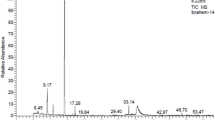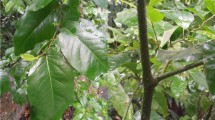Abstract
The volatile metabolites of Greek wild growing Thymus leucospermus and Thymus teucrioides subsp. candilicus were determined by gas chromatography and gas chromatography–mass spectrometry. The monoterpene hydrocarbon p-cymene (64.2%) dominated T. leucospermus oil, followed by γ-terpinene (7.9%), thymol (4.8%), and borneol (4.7%), whereas the most abundant constituents in T. teucrioides subsp. candilicus oil were p-cymene (25.5%), γ-terpinene (19.0%), thymol (18.8%), borneol (5.7%), and α-pinene (5.7%). The larvicidal and repellent activities of the analyzed essential oils were tested on Culex pipiens larvae and adults, respectively. Additionally, the main metabolite of the essential oils, p-cymene was tested against C. pipiens adults in order to define the affiliation between p-cymene and the repellent properties of the oil. The essential oils of T. leucospermus and T. teucrioides subsp. candilicus provided repellency 78.1% and 72.9%, respectively, statistically equal to the reference product icaridin. The compound p-cymene showed almost no repellent activity. The essential oil of T. leucospermus presented lower larvicidal activity (LC50 = 34.26 mgl−1) against C. pipiens third–fourth instar larvae while T. teucrioides subsp. candilicus was the most active with an estimated LC50 value of 23.17 mgl−1.
Similar content being viewed by others
References
Adams RP (2007) Identification of essential oil components by gas chromatography/quadrupole mass spectrometry. Allured Publ Corp, Carol Stream
Amer A, Mehlhorn H (2006a) Larvicidal effects of various essential oils against Aedes, Anopheles, and Culex larvae (Diptera, Culicidae). Parasitol Res 99:466–472
Amer A, Mehlhorn H (2006b) Repellency effect of forty-one essential oils against Aedes, Anopheles and Culex mosquitoes. Parasitol Res 99:478–490
Amer A, Mehlhorn H (2006c) Persistency of larvicidal effects of plant oil extracts under different storage conditions. Parasitol Res 99:473–477
Choi WSC, Park BS, Ku SK, Lee SE (2002) Repellent activities of essential oils and monoterpenes against Culex pipiens pallens. J Am Mosq Control Assoc 18:348–351
Hartvig P (1987) A taxonomical revision of Thymus sect. Teucrioides (Lamiaceae). Pl Syst Evol 155:1997–213
Hubálek Z (2008) Mosquito-borne viruses in Europe. Parasitol Res 103(Suppl 1):S29–S43
Jacob D (2008) Short communication on regional climate change scenarios and their possible use for impact studies on vector-borne diseases. Parasitol Res 103:S3–S6
KEELPNO (2010) Hellenic Centre for Disease Control and Prevention. (http://www.keelpno.gr/index.php?option=com_content&view=article&id=140%3Awest-nile-virus-infection&catid=45%3A2010-06-28-08-41-59&Itemid=1). Accessed 12 Nov 2010
Morales R (1997) Synopsis of the genus Thymus L. in the Mediterranean area. Lagascalia 19:249–262
Nuňez DR, De Castro CO (1992) Palaeoethnobotany and Archaeobotany of the Labiatae in Europe and the near East. In: Harley RM, Reynolds T (eds) Advances in Labiatae Science. Royal Botanic Gardens, Kew, p 437
Park BS, Choi WSC, Kim JH, Kim KH, Lee SE (2005) Monoterpenes from thyme (Thymus vulgaris) as potential mosquito repellents. J Am Mosq Control Assoc 21:80–83
Syed Z, Leal WS (2008) Mosquitoes smell and avoid the insect repellent DEET. PNAS 105:13598–13603
Trabousli AF, Taoubi K, Samih EH, Bessiere JM, Rammal S (2002) Insecticidal properties of essential oils against the mosquito Culex pipiens molestus (Diptera: Culicidae). Pestic Manag Sci 58:491–495
WHO (1981) Instructions for determining the susceptibility or resistance of mosquito larvae to insecticides VBC/81.807. World Health Organization, Geneva
Zhu J, Zeng X, Yanma LT, Qian K, Han Y, Xue S, Tucker B, Schultz G, Coats J, Rowley W, Zhang A (2006) Adult repellency and larvicidal activity of five plant essential oil against mosquitoes. J Am Mosq Control Assoc 22:512–522
Acknowledgements
We would like to thank Ass. Professor Theophanis Constaninidis (Department of Ecology and Systematics, University of Athens) for the collection and identification of the plant material.
Author information
Authors and Affiliations
Corresponding author
Rights and permissions
About this article
Cite this article
Pitarokili, D., Michaelakis, A., Koliopoulos, G. et al. Chemical composition, larvicidal evaluation, and adult repellency of endemic Greek Thymus essential oils against the mosquito vector of West Nile virus. Parasitol Res 109, 425–430 (2011). https://doi.org/10.1007/s00436-011-2271-1
Received:
Accepted:
Published:
Issue Date:
DOI: https://doi.org/10.1007/s00436-011-2271-1




